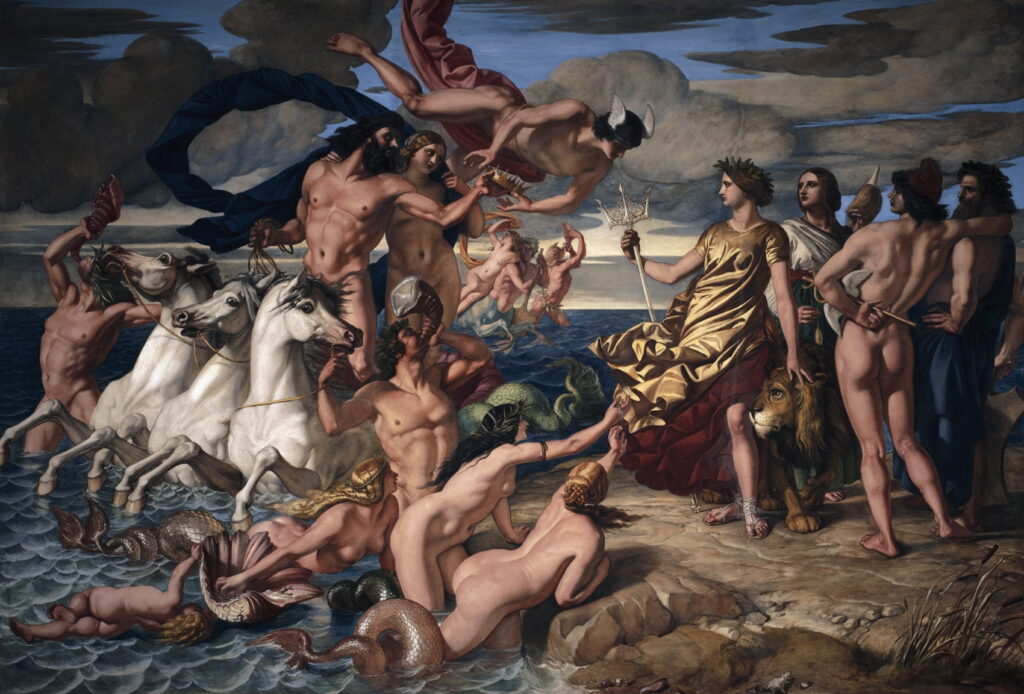Changing Paintings: 41 Shape-shifters and the Old Man of the Sea

As Ovid draws Book 8 of his Metamorphoses to a close, Lelex has just told the touching story of Philemon and Baucis, who were transformed into an intertwining pair of trees. Achelous, host of the banquet, then takes over as narrator, to tell of three examples of shape-shifters, who can transform whenever they want.
His first example is probably the most accomplished of all: Proteus, who apparently can transform himself into all manner of creatures and objects, at one moment a boar, the next a snake or a fire. Both Hans Thoma and Cy Twombly have painted Proteus, but I regret that neither of their works is available to show here.
This leads Achelous on to tell the longer story of another shape-shifter, the daughter of Erysichthon, who remains unnamed here, elsewhere being known as Mestra or Mnestra. But he first has to introduce her father, by telling the story of his downfall.
Erysichthon was an irreligious man, even desecrating Ceres’ sacred grove by chopping down a giant and ancient oak within it. As he prepared to swing his axe at the tree, it shuddered and turned pale. A man stood in his way, so he was peremptorily beheaded. As he raised his axe ready, its nymph warned him that her death would bring him punishment.
The other Dryads (wood nymphs) prayed to Ceres to punish Erysichthon. The goddess decided to bring him insatiable hunger, but as it was decreed that Ceres and the goddess of hunger could never meet, Ceres sent an Oread as her messenger. The Oread found Hunger in the Caucasus mountains, and passed the message. Ovid then gives a detailed account of how Erysichthon was wracked with hunger, even in his dreams. Nothing could satisfy his appetite, and he spent his entire wealth trying to do so. When he ran out of money, he sold his own daughter to raise money for more food.
Erysichthon’s daughter then called on Neptune, who had previously raped her, to be spared from slavery. The god then transformed her into a fisherman, and her father, not recognising his daughter, called on the fisherman to tell him where his daughter had gone. She denied all knowledge of her former female self, and the man who had bought her went away. Knowing her ability to transform herself, Erysichthon sold her to a succession of people, enabling her to cheat on them and be sold again in a different form. He fed his constant hunger from the money she brought him, until he started to eat his own flesh and limbs.
Johann Wilhelm Baur (1600-1640), Erysichthon Sells His Daughter Mestra (c 1630), engraving for Ovid’s Metamorphoses, further details not known. Wikimedia Commons.
Johann Wilhelm Baur’s engraving showing Erysichthon Sells His Daughter Mestra (c 1630) is a simple depiction of Ovid’s story, but has the interesting feature of Neptune, with his traditional horses and trident, down on the water to the right.
It’s Neptune and water that provide a thread running through much of Ovid’s narrative here. For Neptune not only raped Mestra and enabled her shape-shifting, but he is the father of Proteus, the most adept of all shape-shifters, and both Achelous and Neptune are gods of the waters. Neptune has been painted frequently, but I can find no reference to him being shown with his son Proteus, nor with Mestra. But there is one painting in which father and son might appear together.
Nicolas Poussin (1594–1665), The Birth of Venus (1635-36), oil on canvas, 97.2 x 108.1 cm, Philadelphia Museum of Art, Philadelphia, PA. Wikimedia Commons.
Nicolas Poussin’s The Birth of Venus (1635-36) is controversial, as there is no general agreement as to what it is actually about, nor the identity of the goddess at its centre. One reading maintains that its current title is correct, and the central goddess is Venus, who has just been born from sea foam. To the left is clearly Neptune (Poseidon), bearing his trident, and astride his horses. In the far distance, riding on the clouds, Venus’ chariot is being towed towards her by swans.
There are other figures to identify, but one man in the distance at the left edge looks similar to Neptune, and could well be his son, The Old Man of the Sea, Proteus himself. An alternative interpretation is that it’s the sea nymph Galatea, being drawn on a chariot of cockleshells by a school of dolphins, at the centre, rather than Venus.
There is another more recent painting that appears to have been influenced by Poussin’s: William Dyce’s remarkable fresco in Queen Victoria’s holiday palace on the Isle of Wight, Osborne House.
William Dyce (1806–1864), Neptune Resigning to Britannia the Empire of the Sea (1847), fresco, 350 x 510 cm, Osborne House, East Cowes, Isle of Wight, England. Wikimedia Commons.
In Dyce’s Neptune Resigning to Britannia the Empire of the Sea (1847), Neptune stands astride his three white seahorses with their fish tails, holding their reins in his right hand, and passing his crown with the left. The crown is just about to be transferred by Mercury (with wings on his cap) to the gold-covered figure of Britannia, who holds a ceremonial silver trident in her right hand. Neptune is supported by his entourage in the sea, including the statutory brace of nudes and conch-blowers. At the right, Britannia’s entourage is more serious in intent, and includes the lion of England, and figures representing industry, trade, and navigation.
The depiction of Neptune, and much of the left half of the painting, has more than a passing resemblance to Poussin’s. But look into the distance, below Mercury and behind Neptune, and there’s an Old Man of the Sea with two nymphs. Could that also be Proteus?
In the closing lines of the book, Ovid then reveals through Achelous the link to the start of Book 9: Achelous reveals that he too is a shape-shifter, able to transform himself into a snake or a bull. But that bull had recently lost one of its two horns, the basis of the next myth.




